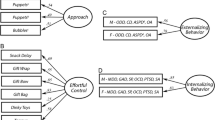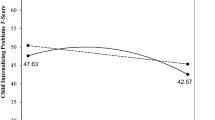Abstract
The current study examined concurrent relationships between children’s self-regulation, measured behaviorally and by parent-report, and children’s internalizing and externalizing symptoms. The aim was to distinguish which components of self-regulation (attention vs. inhibitory control, “hot” vs. “cool” regulation) best predict dimensional symptomatology and clinical disorders in young children. The participants were 120 children, ages 4–8 years old. Results showed that greater parent-reported attention was associated with fewer internalizing and externalizing symptoms. Behaviorally-measured hot inhibitory control related to fewer internalizing symptoms, whereas parent-reported inhibitory control related to fewer externalizing symptoms. Similar patterns emerged for clinical diagnoses, with parent-rated attention most strongly predicting disorders across domains. Results support prior evidence implicating self-regulatory deficits in externalizing problems, while also demonstrating that components of self-regulation are impaired with internalizing symptoms. Further, different sub-components of self-regulation relate to different dimensions of psychopathology in children. Interventions should target these areas in children at-risk for disorders.

Similar content being viewed by others
References
Mischel W, Shoda Y, Rodriguez ML (1989) Delay of gratification in children. Science 244(4907):933
Moffitt TE, Arseneault L, Belsky D, Dickson N, Hancox RJ, Harrington H et al (2011) A gradient of childhood self-control predicts health, wealth, and public safety. Proc Natl Acad Sci U S A 108(7):2693–2698
Robson DA, Allen MS, Howard SJ (2020) Self-regulation in childhood as a predictor of future outcomes: a meta-analytic review. Psychol Bull 146(4):324–354
Eisenberg N, Spinrad TL, Eggum ND (2010) Emotion-related self-regulation and its relation to children’s maladjustment. Annu Rev Clin Psychol 6:495–525
Insel T, Cuthbert B, Garvey M, Heinssen R, Pine DS, Quinn K et al (2010) Research domain criteria (RDoC): toward a new classification framework for research on mental disorders. Am J Psychiatry 167(7):748–751
Derryberry D, Reed M (2001) A multidisciplinary perspective on attentional control. Elsevier Science, New York, NY
Berger A, Kofman O, Livneh U, Henik A (2007) Multidisciplinary perspectives on attention and the development of self-regulation. Prog Neurobiol 82(5):256–286
Eisenberg N, Cumberland A, Spinrad TL, Fabes RA, Shepard SA, Reiser M et al (2001) The relations of regulation and emotionality to children’s externalizing and internalizing problem behavior. Child Dev 72(4):1112–1134
Riggs NR, Blair CB, Greenberg MT (2004) Concurrent and 2-year longitudinal relations between executive function and the behavior of 1st and 2nd grade children. Child Neuropsychol 9(4):267–276
Eggum ND, Eisenberg N, Spinrad TL, Valiente C, Edwards A, Kupfer AS et al (2009) Predictors of withdrawal: possible precursors of avoidant personality disorder. Dev Psychopathol 21(03):815–838
Muris P, Meesters C, Rompelberg L (2007) Attention control in middle childhood: relations to psychopathological symptoms and threat perception distortions. Behav Res Ther 45(5):997–1010
Muris P, Meesters C, Blijlevens P (2007) Self-reported reactive and regulative temperament in early adolescence: relations to internalizing and externalizing problem behavior and “Big Three” personality factors. J Adolesc 30(6):1035–1049
White LK, McDermott JM, Degnan KA, Henderson HA, Fox NA (2011) Behavioral inhibition and anxiety: the moderating roles of inhibitory control and attention shifting. J Abnorm Child Psychol 39(5):735–747
Vuontela V, Carlson S, Troberg AM, Fontell T, Simola P, Saarinen S et al (2013) Working memory, attention, inhibition, and their relation to adaptive functioning and behavioral/emotional symptoms in school-aged children. Child Psychiatry Hum Dev 44(1):105–122
Spinrad TL, Eisenberg N, Gaertner B, Popp T, Smith CL, Kupfer A et al (2007) Relations of maternal socialization and toddlers’ effortful control to children’s adjustment and social competence. Dev Psychol 43(5):1170
Berlin L, Bohlin G, Rydell AM (2003) Relations between inhibition, executive functioning, and ADHD-symptoms: a longitudinal study from age 5 to 8. Child Neuropsychol 9:55–65
Brocki KC, Eninger L, Thorell LB, Bohlin G (2010) Interrelations between executive function and symptoms of hyperactivity/impulsivity and inattention in preschoolers: a two year longitudinal study. J Abnorm Child Psychol 38(2):163–171
Brocki KC, Nyberg L, Thorell LB, Bohlin G (2007) Early concurrent and longitudinal symptoms of ADHD and ODD: relations to different types of inhibitory control and working memory. J Child Psychol Psychiatry 48(10):1033–1041
Chhabildas N, Pennington BF, Willcutt EG (2001) A comparison of the neuropsychological profiles of the DSM-IV subtypes of ADHD. J Abnormal Child Psychol 29(6):529–540
Zelazo PD, Muller U (2002) Executive function in typical and atypical development. In: Goswami U (ed) Blackwell handbook of childhood cognitive development. Blackwell, Malden, pp 445–469
Zelazo PD, Müller U, Frye D, Marcovitch S, Argitis G, Boseovski J (2003) The development of executive function in early childhood. Monogr Soc Res Child Dev 68(3):vii–137
Brock LL, Rimm-Kaufman SE, Nathanson L, Grimm KJ (2009) The contributions of ‘hot’ and ‘cool’ executive function to children’s academic achievement, learning-related behaviors, and engagement in kindergarten. Early Child Res Q 24(3):337–349
Hongwanishkul D, Happaney KR, Lee WS, Zelazo PD (2005) Assessment of hot and cool executive function in young children: age-related changes and individual differences. Dev Neuropsychol 28(2):617–644
Zelazo PD, Carlson SM (2012) Hot and cool executive function in childhood and adolescence: development and plasticity. Child Dev Perspect 6(4):354–360
Kim S, Nordling JK, Yoon JE, Boldt LJ, Kochanska G (2013) Effortful control in “hot” and “cool” tasks differentially predicts children’s behavior problems and academic performance. J Abnorm Child Psychol 41(1):43–56
Backer-Grøndahl A, Nærde A, Idsoe T (2019) Hot and cool self-regulation, academic competence, and maladjustment: mediating and differential relations. Child Dev 90(6):2171–2188
Mischel W, Ebbesen EB (1970) Attention in delay of gratification. J Pers Soc Psychol 16(2):329–337
Gilliom M, Shaw DS, Beck JE, Schonberg MA, Lukon JL (2002) Anger regulation in disadvantaged preschool boys: strategies, antecedents, and the development of self-control. Dev Psychol 38(2):222–235
Zhou Q, Chen SH, Main A (2012) Commonalities and differences in the research on children’s effortful control and executive function: a call for an integrated model of self-regulation. Child Dev Perspect 6(2):112–121
Duckworth AL, Kern ML (2011) A meta-analysis of the convergent validity of self-control measures. J Res Pers 45(3):259–268
Cataldo MG, Nobile M, Lorusso ML, Battaglia M, Molteni M (2005) Impulsivity in depressed children and adolescents: a comparison between behavioral and neuropsychological data. Psychiatry Res 136(2):123–133
Buckner JC, Mezzacappa E, Beardslee WR (2009) Self-regulation and its relations to adaptive functioning in low income youths. Am J Orthopsychiatry 79(1):19–30
Murray KT, Kochanska G (2002) Effortful control: factor structure and relation to externalizing and internalizing behaviors. J Abnorm Child Psychol 30(5):503–514
Lengua LJ (2003) Associations among emotionality, self-regulation, adjustment problems, and positive adjustment in middle childhood. J Appl Dev Psychol 24(5):595–618
Lengua LJ (2008) Anxiousness, frustration, and effortful control as moderators of the relation between parenting and adjustment in middle-childhood. Soc Dev 17(3):554–577
Meyer A (2017) A biomarker of anxiety in children and adolescents: a review focusing on the error-related negativity (ERN) and anxiety across development. Dev Cogn Neurosci 27:58–68
Jaffee SR, Moffitt TE, Caspi A, Fombonne E, Poulton R, Martin J (2002) Differences in early childhood risk factors for juvenile-onset and adult-onset depression. Arch Gen Psychiatry 59(3):215–222
Petty CR, Rosenbaum JF, Hirshfeld-Becker DR, Henin A, Hubley S, LaCasse S et al (2008) The child behavior checklist broad-band scales predict subsequent psychopathology: a 5-year follow-up. J Anxiety Disord 22(3):532–539
Goldsmith HH, Reilly J, Lemery KS, Longley S, Prescott A (1993) Preliminary manual for the preschool laboratory temperament assessment battery (Technical report Version 1.0). Department of Psychology University of Wisconsin—Madison, Madison
Grammer JK, Carrasco M, Gehring WJ, Morrison FJ (2014) Age-related changes in error processing in young children: a school-based investigation. Dev Cogn Neurosci 9:93–105
McDermott JNM, Pérez-Edgar K, Fox NA (2007) Variations of the flanker paradigm: assessming selective attention in young children. Behav Res Methods 39:62–70
Rothbart MK, Ahadi SA, Hershey KL, Fisher P (2001) Investigations of temperament at three to seven years: the children’s behavior questionnaire. Child Dev 72(5):1394–1408
Morris N, Keane S, Calkins S, Shanahan L, O’Brien M (2014) Differential components of reactivity and attentional control predicting externalizing behavior. J Appl Dev Psychol 35(3):121–127
Wright L, Lipszyc J, Dupuis A, Thayapararajah SW, Schachar R (2014) Response inhibition and psychopathology: a meta-analysis of go/no-go task performance. J Abnorm Psychol 123(2):429–439
Achenbach TM, Rescorla LA (2000) Manual for the ASEBA preschool forms & profiles. Research Center for Children, Youth, & Families University of Vermont, Burlington
Achenbach TM, Rescorla LA (2001) Manual for ASEBA school-age forms & profiles. Research Center for Children, Youth, & Families University of Vermont, Burlington
Kaufman J, Birmaher B, Brent D, Rao UMA, Flynn C, Moreci P et al (1997) Schedule for affective disorders and schizophrenia for school-age children-present and lifetime version (K-SADS-PL): initial reliability and validity data. J Am Acad Child Psy 36(7):980–988
Racer KH, Dishion TJ (2012) Disordered attention: Implications for understanding and treating internalizing and externalizing disorders in childhood. Cogn Behav Pract 19(1):31–40
Eisenberg N, Sadovsky A, Spinrad TL, Fabes RA, Losoya SH, Valiente C (2005) The relations of problem behavior status to children’s negative emotionality, effortful control, and impulsivity: concurrent relations and prediction of change. Dev Psychol 41(1):193–211
Ip K, Jester JM, Sameroff A, Olson SL (2019) Linking research domain criteria (RDoC) constructs to developmental psychopathology: the role of self-regulation and emotion knowledge in the development of internalizing and externalizing growth trajectories from ages 3 to 10. Dev Psychol 31(4):1557–1574
Block JH, Block J (1980) The role of ego-control and ego-resiliency in the organization of behavior. In: Collins WA (ed) Minnesota symposium on child psychology, vol 13. Erlbaum, Hillsdale, pp 39–101
Kujawa A, Burkhouse KL (2017) Vulnerability to depression in youth: advances from affective neuroscience. Biol Psychiatry Cogn Neurosci Neuroimaging 2(1):28–37
Acknowledgements
The authors thank the children and families who participated and the research assistants who collected the data. This work was supported by the National Institutes of Mental Health (R03MH102648; MPI: Katherine Rosenblum, Kate Fitzgerald), the Brain Behavior Research Foundation (Kate Fitzgerald), the One Mind- AIM Sullivan Family Rising Star Award (Kate Fitzgerald), the Michigan Institute for Clinical Health Research (UL1TR000433-06; MPI: Kate Fitzgerald, Jason Moser), and the University of Michigan Depression Center (Strategic Translational Research Grant; Jamie Lawler).
Author information
Authors and Affiliations
Corresponding author
Ethics declarations
Conflict of interest
The authors declare that they have no conflict of interest.
Ethical Approval
All procedures performed in studies involving human participants were in accordance with the ethical standards of the institutional and/or national research committee and with the 1964 Helsinki declaration and its later amendments or comparable ethical standards.
Additional information
Publisher's Note
Springer Nature remains neutral with regard to jurisdictional claims in published maps and institutional affiliations.
Rights and permissions
About this article
Cite this article
Lawler, J.M., Pitzen, J., Aho, K.M. et al. Self-regulation and Psychopathology in Young Children. Child Psychiatry Hum Dev 54, 1167–1177 (2023). https://doi.org/10.1007/s10578-022-01322-x
Accepted:
Published:
Issue Date:
DOI: https://doi.org/10.1007/s10578-022-01322-x




